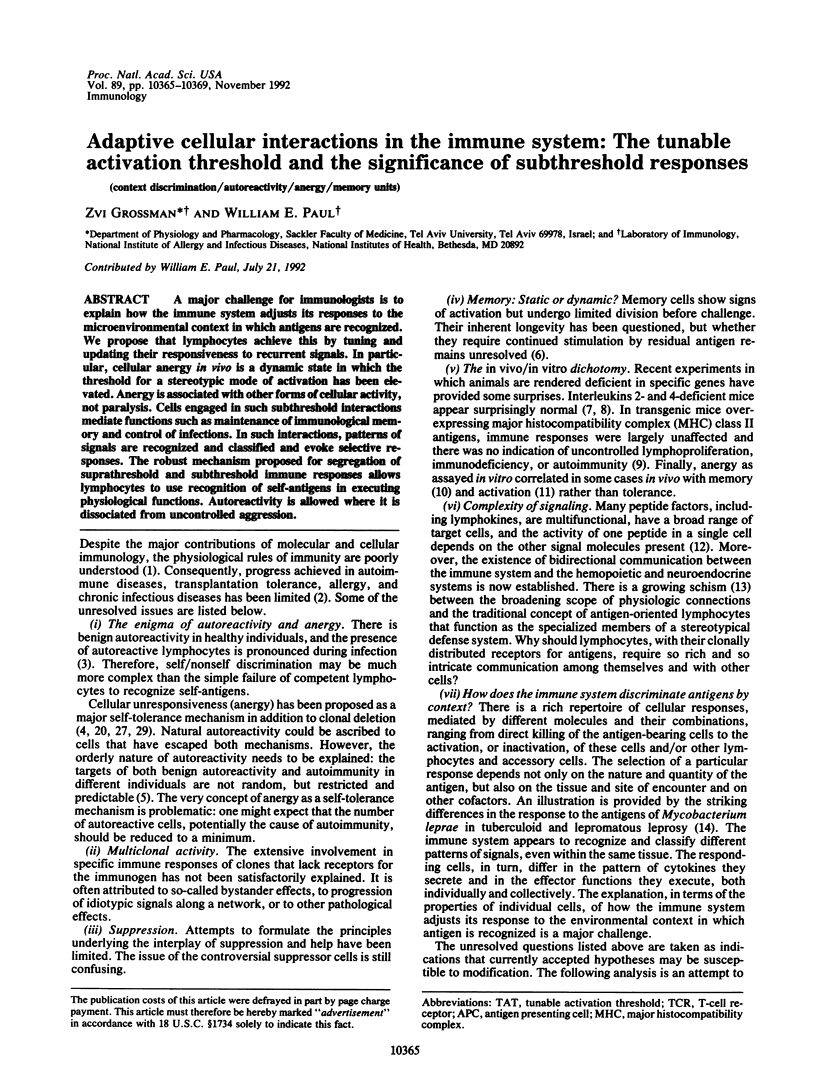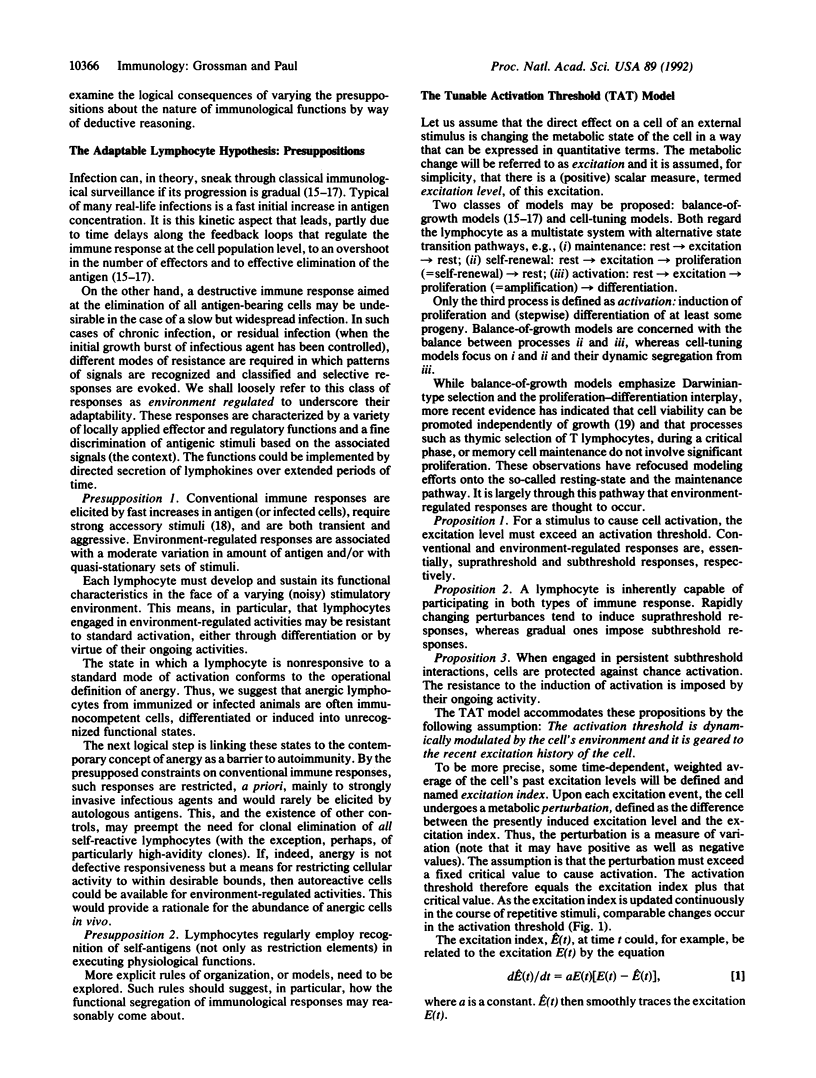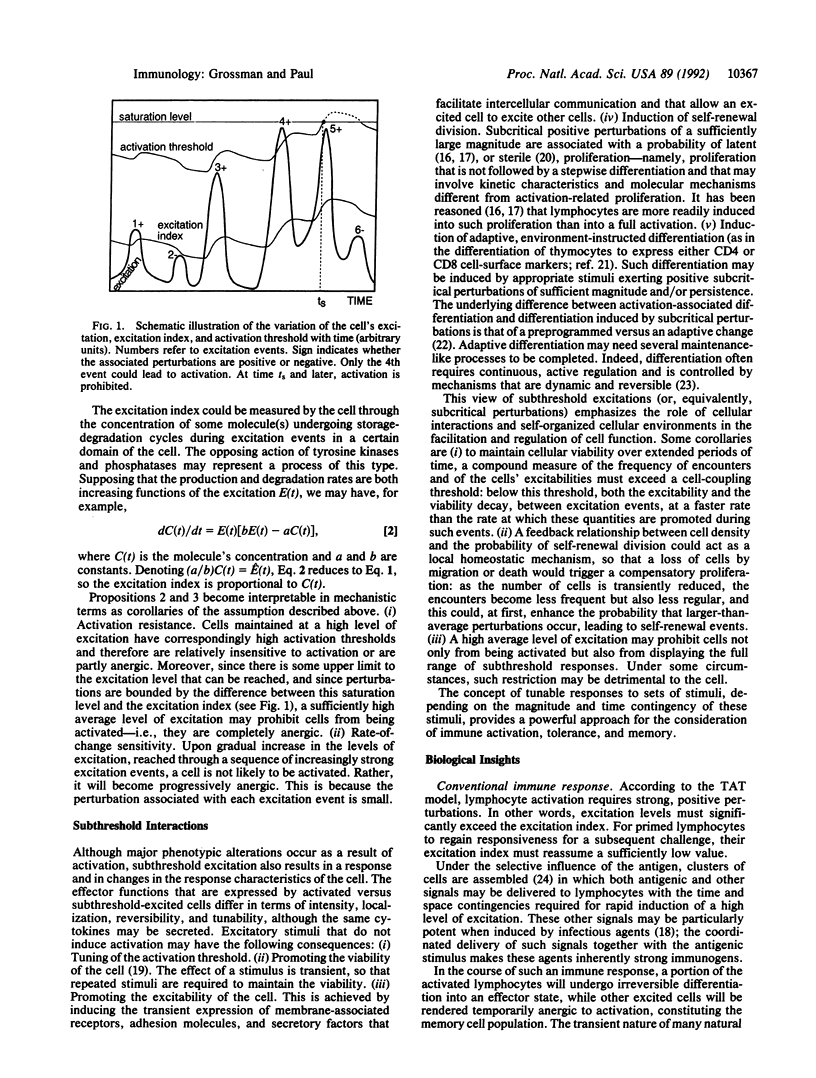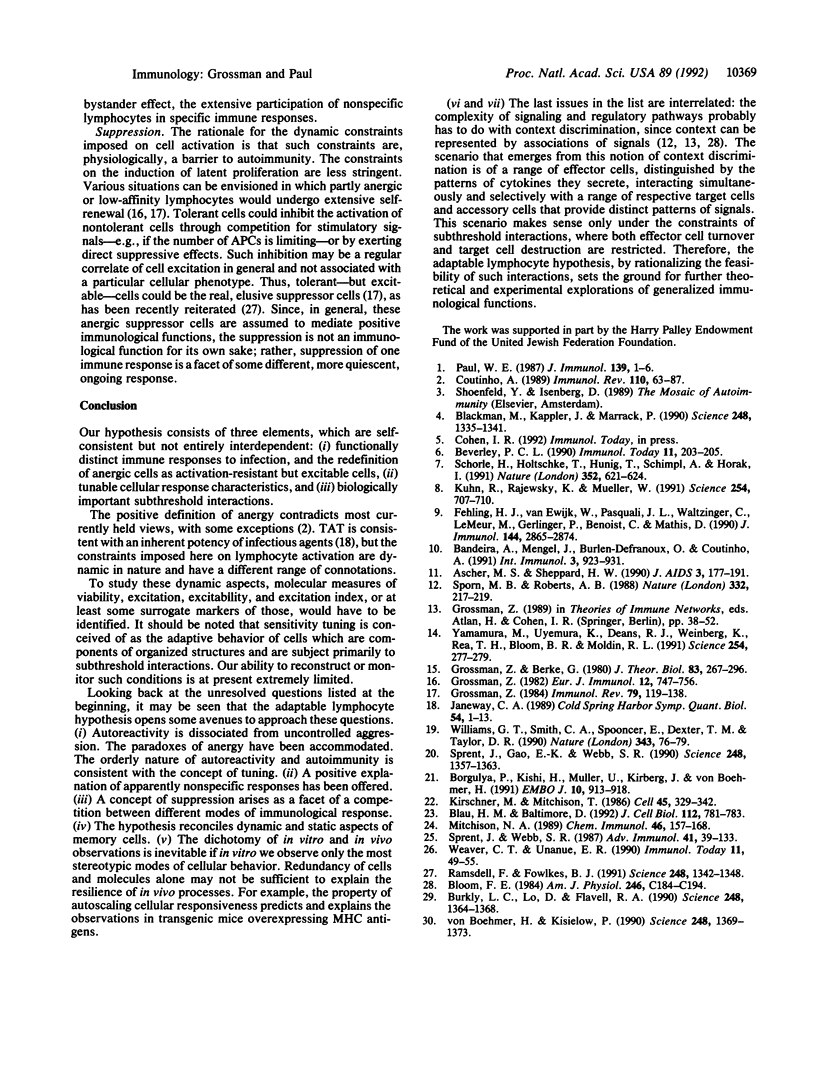Abstract
A major challenge for immunologists is to explain how the immune system adjusts its responses to the microenvironmental context in which antigens are recognized. We propose that lymphocytes achieve this by tuning and updating their responsiveness to recurrent signals. In particular, cellular anergy in vivo is a dynamic state in which the threshold for a stereotypic mode of activation has been elevated. Anergy is associated with other forms of cellular activity, not paralysis. Cells engaged in such subthreshold interactions mediate functions such as maintenance of immunological memory and control of infections. In such interactions, patterns of signals are recognized and classified and evoke selective responses. The robust mechanism proposed for segregation of suprathreshold and subthreshold immune responses allows lymphocytes to use recognition of self-antigens in executing physiological functions. Autoreactivity is allowed where it is dissociated from uncontrolled aggression.
Full text
PDF




Selected References
These references are in PubMed. This may not be the complete list of references from this article.
- Ascher M. S., Sheppard H. W. AIDS as immune system activation. II. The panergic imnesia hypothesis. J Acquir Immune Defic Syndr. 1990;3(2):177–191. [PubMed] [Google Scholar]
- Bandeira A., Mengel J., Burlen-Defranoux O., Coutinho A. Proliferative T cell anergy to MIs-1a does not correlate with in vivo tolerance. Int Immunol. 1991 Sep;3(9):923–931. doi: 10.1093/intimm/3.9.923. [DOI] [PubMed] [Google Scholar]
- Beverley P. C. Is T-cell memory maintained by crossreactive stimulation? Immunol Today. 1990 Jun;11(6):203–205. doi: 10.1016/0167-5699(90)90083-l. [DOI] [PubMed] [Google Scholar]
- Blackman M., Kappler J., Marrack P. The role of the T cell receptor in positive and negative selection of developing T cells. Science. 1990 Jun 15;248(4961):1335–1341. doi: 10.1126/science.1972592. [DOI] [PubMed] [Google Scholar]
- Blau H. M., Baltimore D. Differentiation requires continuous regulation. J Cell Biol. 1991 Mar;112(5):781–783. doi: 10.1083/jcb.112.5.781. [DOI] [PMC free article] [PubMed] [Google Scholar]
- Bloom F. E. The functional significance of neurotransmitter diversity. Am J Physiol. 1984 Mar;246(3 Pt 1):C184–C194. doi: 10.1152/ajpcell.1984.246.3.C184. [DOI] [PubMed] [Google Scholar]
- Borgulya P., Kishi H., Müller U., Kirberg J., von Boehmer H. Development of the CD4 and CD8 lineage of T cells: instruction versus selection. EMBO J. 1991 Apr;10(4):913–918. doi: 10.1002/j.1460-2075.1991.tb08024.x. [DOI] [PMC free article] [PubMed] [Google Scholar]
- Burkly L. C., Lo D., Flavell R. A. Tolerance in transgenic mice expressing major histocompatibility molecules extrathymically on pancreatic cells. Science. 1990 Jun 15;248(4961):1364–1368. doi: 10.1126/science.1694042. [DOI] [PubMed] [Google Scholar]
- Coutinho A. Beyond clonal selection and network. Immunol Rev. 1989 Aug;110:63–87. doi: 10.1111/j.1600-065x.1989.tb00027.x. [DOI] [PubMed] [Google Scholar]
- Fehling H. J., van Ewijk W., Pasquali J. L., Waltzinger C., Le Meur M., Gerlinger P., Benoist C., Mathis D. Functional consequences of overexpressed Ia antigens in AK alpha/AK beta transgenic mice. J Immunol. 1990 Apr 15;144(8):2865–2874. [PubMed] [Google Scholar]
- Grossman Z., Berke G. Tumor escape from immune elimination. J Theor Biol. 1980 Mar 21;83(2):267–296. doi: 10.1016/0022-5193(80)90293-3. [DOI] [PubMed] [Google Scholar]
- Grossman Z. Recognition of self and regulation of specificity at the level of cell populations. Immunol Rev. 1984 Jun;79:119–138. doi: 10.1111/j.1600-065x.1984.tb00490.x. [DOI] [PubMed] [Google Scholar]
- Grossman Z. Recognition of self, balance of growth and competition: horizontal networks regulate immune responsiveness. Eur J Immunol. 1982 Sep;12(9):747–756. doi: 10.1002/eji.1830120909. [DOI] [PubMed] [Google Scholar]
- Janeway C. A., Jr Approaching the asymptote? Evolution and revolution in immunology. Cold Spring Harb Symp Quant Biol. 1989;54(Pt 1):1–13. doi: 10.1101/sqb.1989.054.01.003. [DOI] [PubMed] [Google Scholar]
- Kirschner M., Mitchison T. Beyond self-assembly: from microtubules to morphogenesis. Cell. 1986 May 9;45(3):329–342. doi: 10.1016/0092-8674(86)90318-1. [DOI] [PubMed] [Google Scholar]
- Kühn R., Rajewsky K., Müller W. Generation and analysis of interleukin-4 deficient mice. Science. 1991 Nov 1;254(5032):707–710. doi: 10.1126/science.1948049. [DOI] [PubMed] [Google Scholar]
- Mitchison N. A. Suppression of the response to murine alloantigens: four-cell-type clusters, function-flipping and idiosyncratic responses. Chem Immunol. 1989;46:157–168. [PubMed] [Google Scholar]
- Paul W. E. Between two centuries: specificity and regulation in immunology. J Immunol. 1987 Jul 1;139(1):1–6. [PubMed] [Google Scholar]
- Ramsdell F., Fowlkes B. J. Clonal deletion versus clonal anergy: the role of the thymus in inducing self tolerance. Science. 1990 Jun 15;248(4961):1342–1348. doi: 10.1126/science.1972593. [DOI] [PubMed] [Google Scholar]
- Schorle H., Holtschke T., Hünig T., Schimpl A., Horak I. Development and function of T cells in mice rendered interleukin-2 deficient by gene targeting. Nature. 1991 Aug 15;352(6336):621–624. doi: 10.1038/352621a0. [DOI] [PubMed] [Google Scholar]
- Sporn M. B., Roberts A. B. Peptide growth factors are multifunctional. Nature. 1988 Mar 17;332(6161):217–219. doi: 10.1038/332217a0. [DOI] [PubMed] [Google Scholar]
- Sprent J., Gao E. K., Webb S. R. T cell reactivity to MHC molecules: immunity versus tolerance. Science. 1990 Jun 15;248(4961):1357–1363. doi: 10.1126/science.1694041. [DOI] [PubMed] [Google Scholar]
- Sprent J., Webb S. R. Function and specificity of T cell subsets in the mouse. Adv Immunol. 1987;41:39–133. doi: 10.1016/s0065-2776(08)60030-9. [DOI] [PubMed] [Google Scholar]
- Weaver C. T., Unanue E. R. The costimulatory function of antigen-presenting cells. Immunol Today. 1990 Feb;11(2):49–55. doi: 10.1016/0167-5699(90)90018-5. [DOI] [PubMed] [Google Scholar]
- Williams G. T., Smith C. A., Spooncer E., Dexter T. M., Taylor D. R. Haemopoietic colony stimulating factors promote cell survival by suppressing apoptosis. Nature. 1990 Jan 4;343(6253):76–79. doi: 10.1038/343076a0. [DOI] [PubMed] [Google Scholar]
- Yamamura M., Uyemura K., Deans R. J., Weinberg K., Rea T. H., Bloom B. R., Modlin R. L. Defining protective responses to pathogens: cytokine profiles in leprosy lesions. Science. 1991 Oct 11;254(5029):277–279. doi: 10.1126/science.254.5029.277. [DOI] [PubMed] [Google Scholar]
- von Boehmer H., Kisielow P. Self-nonself discrimination by T cells. Science. 1990 Jun 15;248(4961):1369–1373. doi: 10.1126/science.1972594. [DOI] [PubMed] [Google Scholar]


